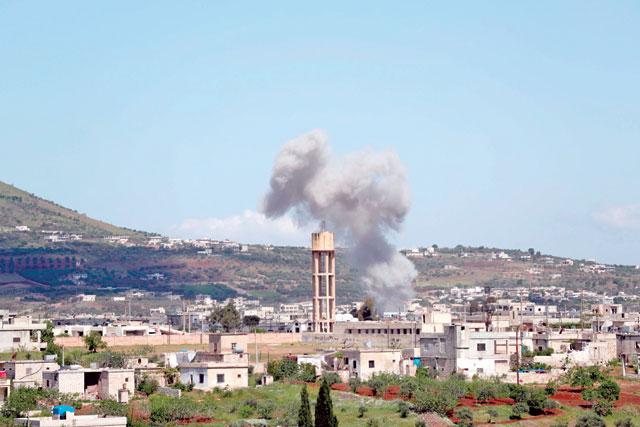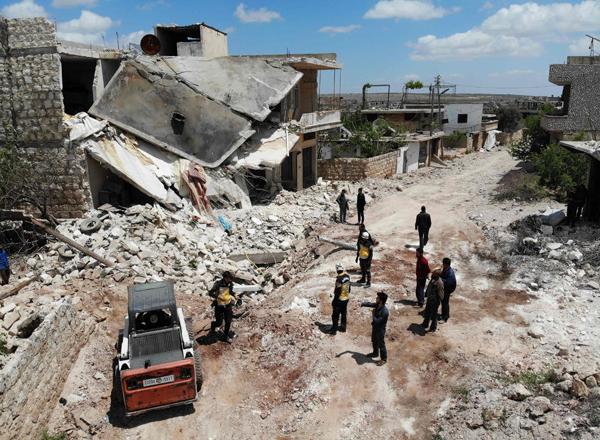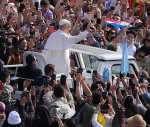You are here
Why the war in Syria's Idlib escalated again
By Reuters - May 09,2019 - Last updated at May 09,2019

A photo taken on Thursday shows rubble and debris following reported shelling on the town of Khan Sheikhun in the southern countryside of the rebel-held Idlib province, Syria (AFP photo)
BEIRUT — A Russian-backed Syrian government offensive in the rebel-held northwest has killed dozens of people and forced more than 150,000 to flee, the biggest escalation in the war between President Bashar Assad and his enemies since last summer.
Government barrel-bombing and Russian air strikes have been accompanied by limited ground assaults, straining a Russian-Turkish deal that spared the region from an offensive in September and generating new concerns for its 3 million people.
Who controls Idlib?
The northwest — Idlib province and a belt of territory around it — is mostly held by the jihadist Tahrir Al Sham, the latest incarnation of the former Al Nusra Front, which was part of Al Qaeda until 2016.
The group tightened its grip earlier this year in a campaign against other rebels. Some of these still have a presence as part of the "National Front for Liberation", backed by Turkey.
Foreign jihadists have a significant presence, many of them members of the Huras Al Din group.
The Turkish military has established about a dozen military positions in the area under its agreements with Russia.
Why has the conflict escalated again?
The Russian-Turkish deal created a demilitarised zone from which jihadists were required to withdraw, effectively putting the onus on Turkey to tackle the problem while leaving the northwest within a sphere of Turkish influence.
But Russia's patience has been wearing thin over what it views as Turkey's failure to curb Tahrir Al Sham. Damascus, determined to recover "every inch" of Syria, has also publicly expressed dissatisfaction with the status quo.
The government accuses the Nusra Front of igniting the violence through attacks on its areas. The rebels accuse the government and "Russian occupiers" of trying to invade.
Where is attack focused, what are its aims?
Most of the bombardment has been in the southern part of the rebel territory including areas in the demilitarised zone.
The full scope of the attack is not yet clear, though Russian President Vladimir Putin recently said a full-scale assault in Idlib was unpractical for now.
Rebel sources believe the government's aim is to seize two highways to Aleppo that run to the south of Idlib city through rebel-held areas. Russia and Turkey had previously agreed these roads should be opened.
Russia's motives in the northwest include securing its Latakia air base from rebel attacks.
What is civilian impact?
The UN Office for the Coordination of Humanitarian Affairs (OCHA) says more than 152,000 people fled between April 29 and May 5, doubling the number of displaced in the northwest since February.
Air strikes have struck 12 health facilities, killed more than 80 civilians and wounded more than 300, OCHA said. Shelling, air strikes and fighting in more than 50 villages have destroyed at least 10 schools and teaching is suspended.
The UN regional humanitarian coordinator has said the barrel bombing is the worst for at least 15 months. Barrel bombs are containers filled with explosives dropped from helicopters.
Could Turkey be
drawn in?
Turkey's response to the latest escalation has been muted, even when shelling from government-held territory struck a Turkish military position on Saturday.
Turkey has recently focused on rolling back Kurdish militia in other parts of northern Syria, notably the area near Tel Rifaat north of Aleppo. Turkey and Russia are in talks over the status of this area.
Turkey, Russia and Iran reaffirmed their commitment to the September agreement on the eve of the latest escalation.
In a joint statement after an April 25-26 meeting, they expressed concern about Tahrir Al Sham's efforts to increase its control and "reaffirmed the determination to continue cooperation" to eliminate terrorists including Al Nusra Front.
Turkey's concerns would grow if the attack widened to the point of threatening another major influx of Syrian refugees. It already hosts 3.6 million.
How do forces stack up?
The Syrian army can draw on the overwhelming fire power provided by the Russian air force and Iran-backed militias that have enabled it to defeat rebels across western Syria. The rebels do not have significant anti-aircraft defences.
Tahrir Al Sham has said it will confront any ground assault by "the Russian occupiers" with "steel and fire". The rebel arsenal includes guided anti-armour missiles, ground-to-ground rockets and suicide bombers.
In a video address this week, a Tahrir Al Sham spokesman said that rebels driven from other parts of Syria — Ghouta, Deraa and Homs — stood ready to defend the territory.
Related Articles
MOSCOW — Russia accused rebels in Syria’s Idlib Province on Thursday of trying to wreck a Russian-Turkish initiative to create a demilitaris
BEIRUT/ANKARA — Syrian government forces and their Russian allies pounded the rebel-held northwest of Syria with air strikes on Saturday, so
BEIRUT — In part of northern Syria's last rebel enclave, doctors have pulled back into cave shelters to treat the wounded and protect their
















